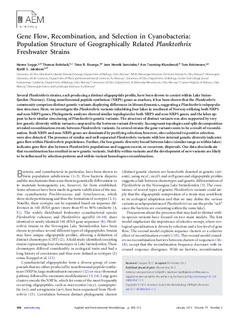| dc.contributor.author | Sogge, Hanne | |
| dc.contributor.author | Rohrlack, Thomas | |
| dc.contributor.author | Rounge, Trine Ballestad | |
| dc.contributor.author | Sønstebø, Jørn Henrik | |
| dc.contributor.author | Tooming-Klunderud, Ave | |
| dc.contributor.author | Kristensen, Tom | |
| dc.contributor.author | Jakobsen, Kjetill Sigurd | |
| dc.date.accessioned | 2018-04-13T12:13:59Z | |
| dc.date.available | 2018-04-13T12:13:59Z | |
| dc.date.created | 2013-01-25T13:36:18Z | |
| dc.date.issued | 2013 | |
| dc.identifier.citation | Applied and Environmental Microbiology. 2013, 79 (2), 508-515. | nb_NO |
| dc.identifier.issn | 0099-2240 | |
| dc.identifier.uri | http://hdl.handle.net/11250/2494079 | |
| dc.description.abstract | Several Planktothrix strains, each producing a distinct oligopeptide profile, have been shown to coexist within Lake Steinsfjorden (Norway). Using nonribosomal peptide synthetase (NRPS) genes as markers, it has been shown that the Planktothrix community comprises distinct genetic variants displaying differences in bloom dynamics, suggesting a Planktothrix subpopulation structure. Here, we investigate the Planktothrix variants inhabiting four lakes in southeast of Norway utilizing both NRPS and non-NRPS genes. Phylogenetic analyses showed similar topologies for both NRPS and non-NRPS genes, and the lakes appear to have similar structuring of Planktothrix genetic variants. The structure of distinct variants was also supported by very low genetic diversity within variants compared to the between-variant diversity. Incongruent topologies and split decomposition revealed recombination events between Planktothrix variants. In several strains the gene variants seem to be a result of recombination. Both NRPS and non-NRPS genes are dominated by purifying selection; however, sites subjected to positive selection were also detected. The presence of similar and well-separated Planktothrix variants with low internal genetic diversity indicates gene flow within Planktothrix populations. Further, the low genetic diversity found between lakes (similar range as within lakes) indicates gene flow also between Planktothrix populations and suggests recent, or recurrent, dispersals. Our data also indicate that recombination has resulted in new genetic variants. Stability within variants and the development of new variants are likely to be influenced by selection patterns and within-variant homologous recombination. | nb_NO |
| dc.language.iso | eng | nb_NO |
| dc.publisher | American Society for Microbiology | nb_NO |
| dc.title | Gene Flow, Recombination, and Selection in Cyanobacteria: Population Structure of Geographically Related Planktothrix Freshwater Strains | nb_NO |
| dc.type | Journal article | nb_NO |
| dc.type | Peer reviewed | nb_NO |
| dc.description.version | publishedVersion | nb_NO |
| dc.rights.holder | Copyright © 2013, American Society for Microbiology. All Rights Reserved. | nb_NO |
| dc.source.pagenumber | 508-515 | nb_NO |
| dc.source.volume | 79 | nb_NO |
| dc.source.journal | Applied and Environmental Microbiology | nb_NO |
| dc.source.issue | 2 | nb_NO |
| dc.identifier.doi | 10.1128/AEM.02417-12 | |
| dc.identifier.cristin | 997633 | |
| dc.relation.project | Norges forskningsråd: 183360 | nb_NO |
| cristin.unitcode | 7464,30,19,0 | |
| cristin.unitname | Ferskvannsøkologi | |
| cristin.ispublished | true | |
| cristin.fulltext | original | |
| cristin.qualitycode | 2 | |
